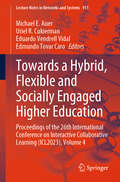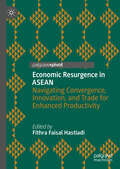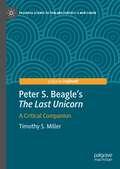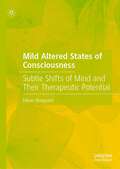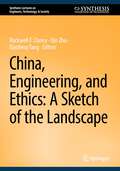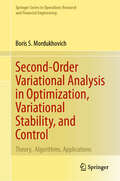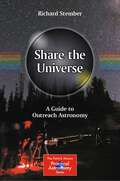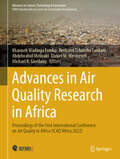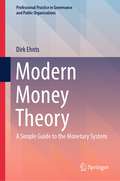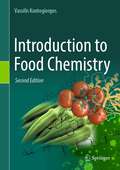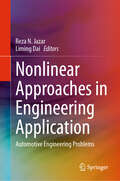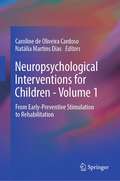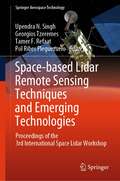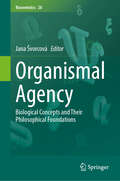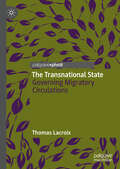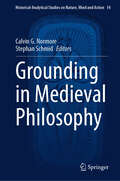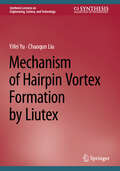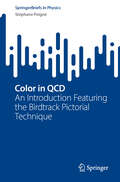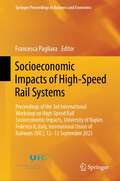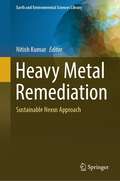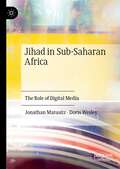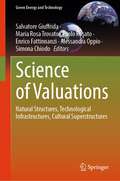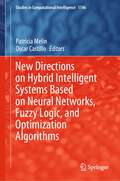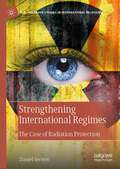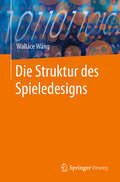- Table View
- List View
Towards a Hybrid, Flexible and Socially Engaged Higher Education: Proceedings of the 26th International Conference on Interactive Collaborative Learning (ICL2023), Volume 4 (Lecture Notes in Networks and Systems #911)
by Michael E. Auer Uriel R. Cukierman Eduardo Vendrell Vidal Edmundo Tovar CaroWe are currently witnessing a significant transformation in the development of education on all levels and especially in post-secondary education. To face these challenges, higher education must find innovative and effective ways to respond in a proper way. The pandemic period left us with profound changes in the way we teach and learn, including the massive use of new means of communication, such as videoconferencing and other technological tools. Moreover, the current explosion of artificial intelligence tools, mainly used by students, is challenging teaching practices maintained for centuries. Scientifically based statements as well as excellent best practice examples are absolutely necessary.The 26th International Conference on Interactive Collaborative Learning (ICL2023), which will take place in Madrid, Spain, between 26th and 30th September 2023, will be the perfect place where to present and discuss current trends in Higher Education.Since its beginning in 1998 this conference is devoted to new approaches in learning with a focus on collaborative learning in Higher Education. Nowadays the ICL conferences are a forum of the exchange of relevant trends and research results as well as the presentation of practical experiences in Learning and Engineering Pedagogy. In this way we try to bridge the gap between ‘pure’ scientific research and the everyday work of educators.
Economic Resurgence in ASEAN: Navigating Convergence, Innovation, and Trade for Enhanced Productivity
by Fithra Faisal HastiadiThis book provides unique insight into economic development within the ASEAN region and its recovery from the COVID-19 pandemic. With a particular focus on Indonesia, it highlights the historic importance of manufacturing within the region and how the sector remains vital, despite the Asian financial crisis, and central to sustainable and inclusive economic growth. The growing influence of digital technologies, including remote work, online services, and digital marketplaces, are highlighted, particularly in relation to economic mitigation and recovery from the COVID-19 pandemic. Broader issues, such as FDI, human development, regional integration, R&D spillovers, labour productivity, and bilateral trade, are also discussed.This book highlights how ASEAN economies can be strengthened by innovation, trade, and increased productivity. It will be relevant to students and researchers interested in development and international economics.
Peter S. Beagle's “The Last Unicorn”: A Critical Companion (Palgrave Science Fiction and Fantasy: A New Canon)
by Timothy S. MillerThis book assesses the work of one of the foundational figures of American fantasy, Peter S. Beagle. Through its focused analysis of The Last Unicorn, this study contextualises Beagle’s work in relation to the popularity of the fantasy genre, following its growing success in the aftermath of Tolkien’s The Lord of the Rings. In addition, through reference to the film adaptation of The Last Unicorn and also Beagle’s other works, this study highlights the author’s longevity and the influence that his metafictional and comedic work has had on contemporary fantasy.
Mild Altered States of Consciousness: Subtle Shifts of Mind and Their Therapeutic Potential
by Eileen SheppardThis book draws on transpersonal anthropology and psychology in order to explore mild altered states of consciousness (ASCs) experienced in everyday life. While research into consciousness and particularly ASCs is growing, this book focuses on a neglected area: ‘everyday’ experiences of ASCs. Opening with an up-to-date overview of the development of the study of ASCs, the author presents an in-depth empirical exploration and mapping of mild ASCs. Dr Sheppard examines original research conducted in a range of religious and secular contexts with participants who were engaged in activities including prayer, sport, nature conservation, music and musical instrument making, and TV viewing. The author takes a novel phenomenological approach to the analysis of ASCs, emphasising the subjective experience. The book explores the healing potential of such mild ASCs; the everyday fantasy reality of the interior landscape; and discusses the problem of validity, and belief in the study of ASCs. It will appeal to students and scholars of transpersonal psychology, consciousness studies, social anthropology, and the philosophy of mind.
China, Engineering, and Ethics: A Sketch of the Landscape (Synthesis Lectures on Engineers, Technology, & Society)
by Rockwell F. Clancy Qin Zhu Xiaofeng TangChina is a leading engineering country, fueling unprecedented global development. Technology and educational exchanges bring Chinese organizations, practitioners, and students together with similar groups from around the world. These collaborations depend on ethical and cultural considerations as much as technical expertise. To facilitate understanding and strengthen cooperation, this volume provides an overview of current research and discussions related to China, engineering, and ethics. It includes perspectives from experts in engineering and technology ethics with first-hand China experience.This volume seeks to promote understandings of Chinese cultural and social contexts that are central to ethical engineering. By reading, discussing, and applying the knowledge contained in this volume, the hope is that scholars, policymakers, and (especially) engineers working in and/or with China will have a better understanding of Chinese culture and history, and how theseaffect practices surrounding engineering and technology. In turn, such understanding would lead to greater cooperation, better realizing the global benefits of ethical engineering.
Second-Order Variational Analysis in Optimization, Variational Stability, and Control: Theory, Algorithms, Applications (Springer Series in Operations Research and Financial Engineering)
by Boris S. MordukhovichThis fundamental work is a sequel to monographs by the same author: Variational Analysis and Applications (2018) and the two Grundlehren volumes Variational Analysis and Generalized Differentiation: I Basic Theory, II Applications (2006). This present book is the first entirely devoted to second-order variational analysis with numerical algorithms and applications to practical models. It covers a wide range of topics including theoretical, numerical, and implementations that will interest researchers in analysis, applied mathematics, mathematical economics, engineering, and optimization. Inclusion of a variety of exercises and commentaries in each chapter allows the book to be used effectively in a course on this subject. This area has been well recognized as an important and rapidly developing area of nonlinear analysis and optimization with numerous applications. Consisting of 9 interrelated chapters, the book is self-contained with the inclusion of some preliminaries in Chapter 1.Results presented are useful tools for characterizations of fundamental notions of variational stability of solutions for diverse classes of problems in optimization and optimal control, the study of variational convexity of extended-real-valued functions and their specifications and variational sufficiency in optimization. Explicit calculations and important applications of second-order subdifferentials associated with the achieved characterizations of variational stability and related concepts, to the design and justification of second-order numerical algorithms for solving various classes of optimization problems, nonsmooth equations, and subgradient systems, are included. Generalized Newtonian algorithms are presented that show local and global convergence with linear, superlinear, and quadratic convergence rates. Algorithms are implemented to address interesting practical problems from the fields of machine learning, statistics, imaging, and other areas.
Share the Universe: A Guide to Outreach Astronomy (The Patrick Moore Practical Astronomy Series)
by Richard StemberAs every astronomer knows, astronomy is one of the most approachable and inspiring of the natural sciences. It appeals to both children and adults while drawing in curious minds with its immense distances and unimaginably powerful natural phenomena. In this book, you will find out how to be a part of the journey in sharing scientific knowledge and inspiring minds of all ages. By using the affordable tools and techniques provided in this book – you will learn about how astronomers can easily engage people with views of our solar system’s planets, moons, and even more distant objects like nebulas, stellar nurseries, and remnants of exploded stars. Perhaps most importantly, the natural appeal of this science is helpful when explaining to non-scientists how science “works." What is science and scientific methodology? How is it used to give mankind knowledge and solutions to problems that we face in many scientific fields including medicine? How does it differ from other sources of information? This book, sprinkled with the author’s 24 plus years of personal experience in public outreach, offers practical techniques to engage, educate, and inspire all who are interested in the field of astronomy.
Advances in Air Quality Research in Africa: Proceedings of the First International Conference on Air Quality in Africa (ICAQ'Africa 2022) (Advances in Science, Technology & Innovation)
by Abdelwahid Mellouki Khanneh Wadinga Fomba Bertrand Tchanche Fankam Daniel M. Westervelt Michael R. GiordanoThis book presents the recent findings on air quality in Africa from the virtual event of the first International Conference on Air Quality in Africa (ICAQ 2022), providing a comprehensive overview on many subjects of air pollution that affect African society. It highlights research progress in the chemical and physical characterization of air pollutants, their related respiratory and non-respiratory health effects, measurements and monitoring of air pollutants using satellite remote sensing and modeling techniques, currently implemented abatement policies in different African countries, existing research and networking infrastructures, and novel tools for monitoring air quality. The advances in the development of local cost-effective air quality monitoring tools in Africa as well as the use of low-cost sensors in quantifying air quality levels are presented. This book is an enrichment for researchers, experts, and advocates of air quality, atmospheric chemistry and physics, satellite remote sensing applications, and policymakers in Africa.
Modern Money Theory: A Simple Guide to the Monetary System (Professional Practice in Governance and Public Organizations)
by Dirk EhntsThis book explains how central banks, banks and governments create money. Written in an accessible style, this book provides an introduction to modern monetary theory without requiring any prior knowledge of economics. It covers the most important aspects of monetary theory, including inflation targeting, government spending, and international trade, as well as economic policy to achieve macroeconomic goals, such as price stability, full employment and sustainable use of resources. Accordingly, it offers a valuable asset for students of economics, central bankers, banking professionals, and academics alike.
Introduction to Food Chemistry
by Vassilis KontogiorgosThe complexity of food chemistry makes it a challenging subject for students studying in a food science course. Although there are excellent food chemistry books available in the market they have two major flaws: they are either encyclopedic or they are not pitched correctly to undergraduate food science students. The first problem creates difficulties for students to identify what is important and how much they need to know. The second problem arises when the book is written by authors that are not food scientists (e.g., chemists), they are not academics that are engaged with teaching or they are not sufficiently qualified to teach. In this case, it is difficult to find links between the chemistry of foods and its relevance to applications or, quite frequently, future employment prospects of the student. Introduction to Food Chemistry, 2nd Edition bridges this gap in the relevant literature, as it employs the latest pedagogical theories in textbook writing to present the subject to students with broad range of cognitive skills. This book presents specific learning objectives for each chapter and is self-contained so students will not need to search for essential information outside the textbook. This new edition has been expanded to include chapters on sweeteners, glass transition, amino acids, proteins for major food commodities and food additives. All of the original chapters have been updated and expanded to include new research and technologies. To support learning, the book has:Didactic elements with information being conveyed with 3D-figures, color-coded schemes and graphs, annotations on figures that link it to the text descriptionsBuilt-in pedagogy and learning activities at the end of each chapter that are linked to the learning objectives.Keywords and concepts for online search to instigate curiosity for further studies.Conversational writing style without losing academic rigorTo support lecturers, the book has:Helps focus teaching preparation on key aspects of food chemistry relevant to both industry and modern research.Aids the preparation of exams, assignments and other types of assessment or learning activities.For lecturers in search of a singular source to aid in their introductory food chemistry courses, look no further than this expanded new edition of Introduction to Food Chemistry.
Nonlinear Approaches in Engineering Application: Automotive Engineering Problems
by Reza N. Jazar Liming DaiThis book focuses on the latest applications of nonlinear approaches in engineering and addresses a range of scientific problems. Examples focus on issues in automotive technology with a strong emphasis on application, physical meaning, and methodologies of the approaches. The book’s chapters are written by world-class experts who advance the future of engineering by discussing the development of more optimal, accurate, efficient, cost, and energy-effective systems. Topics covered are of high interest in engineering and physics, and an attempt has been made to expose engineers and researchers to a broad range of practical topics and approaches. Nonlinear Approaches in Engineering Application: Automotive Engineering Problems is appropriate for researchers, students, and practicing engineers interested in the applications of nonlinear approaches to solving engineering and science problems.
Neuropsychological Interventions for Children - Volume 1: From Early-Preventive Stimulation to Rehabilitation
by Caroline de Oliveira Cardoso Natália Martins DiasThis book is the first of two volumes that aim to serve as a comprehensive guide for professionals working with neuropsychological interventions especially designed for children. This first volume presents the theoretical foundations, tips and guidelines for neuropsychologists to develop different interventions, such as stimulation and early intervention with a focus on promoting neuropsychological health; habilitation, appropriate for work with neurodevelopment disorders; and rehabilitation, in cases of structural alterations. In this sense, it reflects the editors' concern to provide material with practical tips, but theoretically grounded, and truly useful to professionals in clinical and also school contexts. This first volume is divided into two parts. The first addresses the theoretical and practical foundations of child neuropsychological assessment and intervention. Neuropsychological assessment is discussed, with a focus on its role in guiding intervention. Also, different types of interventions are presented, and a taxonomy is offered, according to its differential objectives of promotion or remediation and the target population (typical development, functional or structural alterations of the Nervous System), leading to the suggestion of three types of interventions in neuropsychology in both clinical and school contexts: 1) Early preventive Intervention; 2) Habilitation and 3) Rehabilitation. Cognitive stimulation in different contexts, such as school, family and clinical, is also discussed, exploring how teachers and parents can also collaborate in intervention processes, expanding the possibilities for action beyond the clinical context. A section concludes by addressing the importance of the feedback and the neuropsychological assessment report.The second part focuses specifically on stimulation and rehabilitation, offering chapters that target specific skills such as attention, memory, executive functions and academic skills, among others. The chapters summarize evidence, bring tips and illustrate existing materials and programs, in a continuous articulation between theory-evidence-practice. Originally published in Portuguese and now available in English, Neuropsychological Interventions for Children – Volumes 1 and 2 will be of interest to professionals working with neuropsychology in clinical and school contexts. It will also be useful in neuropsychology teaching contexts (specialization courses in neuropsychology and related areas) and for students and professionals in interface areas, such as Psychology, Education, Speech Therapy, Occupational Therapy among others. The translation of the original Portuguese version of this book into English was done with the help of artificial intelligence. A subsequent human revision was done primarily in terms of content.
Space-based Lidar Remote Sensing Techniques and Emerging Technologies: Proceedings of the 3rd International Space Lidar Workshop (Springer Aerospace Technology)
by Upendra N. Singh Georgios Tzeremes Tamer F. Refaat Pol Ribes PleguezueloThis book gathers the latest advances, innovations, and applications in the field of space lidar missions, techniques, and technologies, as presented at the 3rd International Workshop on Space-Based Lidar Remote Sensing Techniques and Emerging Technologies (LIDAR), held in Milos Island, Greece, on June 18–23, 2023. It covers highly diverse topics such as space-based lidar techniques and methodologies; challenges experienced in space lidar missions; planning of new space earth observation lidar missions, including monitoring of topography, cryosphere, biomass, greenhouse and trace gases clouds, aerosols; exploration lidars, including entry, decent and precision landing, as well as hazard avoidance for Mars & Lunar landers missions; results and plans for simulations, airborne experiments and demonstrations as precursors for space missions; emerging space lidar technologies, particularly in lasers, optics, electronics and detectors as well as space lidar reliability and influencing factors, such as effects of the space environment. Written by leading scientists and technologists from government agencies, industries and universities, and selected by means of a rigorous international peer-review process, the contributions highlight numerous exciting ideas that will spur novel research directions and foster multidisciplinary collaborations.
Organismal Agency: Biological Concepts and Their Philosophical Foundations (Biosemiotics #28)
by Jana ŠvorcováThis book explores the notion of organismal agency from the perspective of both philosophy and biology. The two sections of the book delve into parallel themes, including distinctions between organic and inorganic nature, self-organization, autonomy, self-presentation, memory, umwelt, and environmental influence. The philosophical part focuses on the influential thinkers who shaped our perception of living entities beyond mere mechanisms. It scrutinizes the concepts of organism and nature in the works of Aristotle, Kant, Schelling, and various processualists. Each chapter explores facets of their ideas that directly or indirectly foreshadowed or contributed to the formulation of the concept of agency. The biological part of the book investigates various concepts associated with agency such as experience, meaning attribution, and phenotypic plasticity, as well as reproduction, organisational constraints, modularity, development of integrated phenotypes, organismal choices, or self-representation through animal organisation. In essence, this work offers a comprehensive examination of organismal agency and its philosophical and biological foundations. Collaboratively authored by individuals from several institutions, this publication caters primarily to researchers and students working at the intersection of philosophy and biology.
The Transnational State: Governing Migratory Circulations
by Thomas LacroixThis work in two parts examines the relations between transnational societies and states. The second volume of this work contends that current policies meant to control or enhance transnational flows have led to the emergence of a transnational policy apparatus coined the transnational state. This book proposes an innovative conceptual framework to grasp the transformations of the contemporary state in both sending and receiving countries. It shows how states expand beyond national territorial limits by reaching out to migrants where they are. In response to the migrants’ endeavours to circumvent the constrains imposed by selective migration policies, public authorities expand the reach of their control beyond (externalisation), within (internalisation) and at (expansion) borders. A totalitarian temptation seems to have seized contemporary state bureaucracies, affecting the very nature of borders and societies. The core argument of this research is that the development of the transnational state is not random. It is a process shaping and shaped by the structures of the transnational society.
Grounding in Medieval Philosophy (Historical-Analytical Studies on Nature, Mind and Action #14)
by Calvin G. Normore Stephan SchmidThis book offers a selection of 13 case studies on how the notion of grounding helps illuminate philosophical discussions of our past with a special focus on debates of the Middle Ages. It thereby makes not only the case that the notion of grounding, which has become so widely debated in analytic metaphysics, has a long and venerable tradition, but also shows that this tradition has a lot to teach to contemporary philosophers of grounding. This is because the historical authors discussed in this volume – that is, Aristotle, Fazang, Boethius, Avicenna, Abelard, Aquinas, Scotus, Ockham, Buridan, Suárez, Leibniz, and others – suggested different types of non-efficient-causal explanations which are to be carefully distinguished. This volume illustrates how philosophy and history of philosophy can be mutually illuminating by showing that the terminology developed in the contemporary debate about grounding can help reconstruct philosophical discussions from Antiquity up to the Early Modern Period, and that these very discussions enrich, and in part challenge the contemporary debate about grounding. In this vein, it is an important reading for everyone interested in the history of grounding and the philosophical insights that this history might have left to us.
Mechanism of Hairpin Vortex Formation by Liutex (Synthesis Lectures on Engineering, Science, and Technology)
by Yifei Yu Chaoqun LiuThis book presents the importance of the mechanism of hairpin vortex formation to understanding flow transition, turbulence, and flow control. This book blends direct numerical simulation (DNS) and mathematical analysis with experiments to create a foundation for understanding turbulence. The authors discuss hairpin vortex as a main component of transitional flow and turbulent flow. In addition, Liutex is utilized and described as a theoretical system that presents valid tools for turbulence research. Readers are exposed to understanding 3D and non-linear instability; the Lambda vortex formation; sweeps, ejections, and shear instability; the Kelvin-Helmholtz instability and vortex ring formation; and turbulence generation and sustenance.
Color in QCD: An Introduction Featuring the Birdtrack Pictorial Technique (SpringerBriefs in Physics)
by Stéphane PeignéThis book introduces readers to the fascinating world of quantum chromodynamics (QCD) and quarks and gluons, the elementary constituents of protons, neutrons, and all hadrons. Specifically, it focuses on the color of quarks and gluons, responsible for their mutual interactions via the strong force. The book provides an elementary introduction to the birdtrack technique, which is a powerful tool for addressing the color structure of QCD in a pictorial way. The technique shows how quark and gluon colors are combined and mixed in QCD. The author discusses color conservation, shows how to project on color states of systems of quarks, antiquarks, and gluons, how to derive their color charges. The book is enriched with many exercises integrated in the text to learn by doing.This book is primarily intended for particle physics students, graduates, and researchers working in the field of QCD. However, it requires no specific prerequisites in QCD, so it may also be of interest to students of mathematics, as an illustration of the use of the birdtrack pictorial technique in representation theory.
Socioeconomic Impacts of High-Speed Rail Systems: Proceedings of the 3rd International Workshop on High-Speed Rail Socioeconomic Impacts, University of Naples Federico II, Italy, International Union of Railways (UIC), 12–13 September 2023 (Springer Proceedings in Business and Economics)
by Francesca PagliaraThis book offers new insights into the wider socio-economic impacts of high-speed rail (HSR). Over the past few decades, significant investments have been made in these systems around the world. The use of public funds for the construction of high-speed rail offers a range of benefits, such as time savings, increased comfort, and reduced traffic congestion, as well as broader economic benefits, including the advancement of less developed regions. These proceedings feature papers presented at the 3rd International Workshop on the Socioeconomic Impacts of High-Speed Rail. The focus is on HSR impacts on the environment, on the land use system, on investment, on the tourism industry, on inclusion and on cooperation vs integration with other transport modes. The book provides an overview of the current state of practice from both theoretical and empirical perspectives. Consequently, it will be of interest to scholars of transportation economics and related fields, as well as transportation industry professionals.
Heavy Metal Remediation: Sustainable Nexus Approach (Earth and Environmental Sciences Library)
by Nitish KumarHeavy metals, in general trace elements, are one of the major environmental problems. Nowadays, increasing environmental and global public health concerns related with environmental contamination by heavy metals are well known. Moreover, human exposure has risen dramatically because of an exponential increase of their use in several activities such as agricultural, industrial, technological and urban applications. They are presented in soils, water and atmosphere and they are a serious risk for the food chain.Approximately 10 million contaminated sites have been reported globally, occupying approximately 49.42 million acres of land, of which >50% is contaminated with toxic heavy metals. This situation warrants immediate attention to limit the introduction of heavy metals into soil systems and to remove the prevailing heavy metals from polluted soils. However, the majorities of existing heavy-metal-removal technologies are expensive, inefficient, or generate secondary pollutants. Therefore, it is of great importance to develop cheaper, environmentally friendly and sustainable approaches (including the development of new immobilizing agents) to manage and rehabilitate heavy-metal-contaminated soils. In the light of the aforementioned facts, this book sheds light on this global environmental issue, and proposes solutions to contamination through multi-disciplinary approaches and case studies from different parts of the world. It addresses sustainable heavy metal contamination remediation strategies using the potential applications of recent biological technology such as biotechnology, bioremediation, phytoremediation, biochar, absorbent, genetic engineering, and nanotechnology approaches. This book is of interest to researchers, teachers, environmental scientists, environmental engineers, environmentalists, and policy makers. Also, the book serves as additional reading material for undergraduate and graduate students of environmental microbiology, biotechnology, eco-toxicology, environmental remediation, waste management, and environmental sciences as well as the general audience.
Jihad in Sub-Saharan Africa: The Role of Digital Media
by Jonathan Matusitz Doris WesleyThis book examines how jihadist groups in sub-Saharan Africa have managed to advance their extremist agenda and recruit new followers thanks to digital media fueled by the information revolution since the dawn of the 21st century. This examination is based on a mixture of historical accounts, contemporary descriptions, case studies, theoretical applications, and an in-depth applied study (in the late chapters of the manuscript). An important conclusion is that the progress of jihadism in sub-Saharan Africa has been commensurate with the development and availability of digital media. This book breaks new ground in three ways. It is the first major academic work to devote most of its content exclusively to the use of digital media by jihadist groups in that region. Examples of jihadist digital media include social networking sites, online instructional videos, propaganda videos, and online jihadist magazines―among others. Secondly, it provides detailed case studies of both well-knownAfrican groups (e.g., Al-Shabaab, Boko Haram) and lesser-known ones― e.g., the Allied Democratic Forces in the Congo (which have, nevertheless, wreaked so much damage). Lastly, it is the first book to include an in-depth thematic analysis of online jihadist magazines―Inspire, Dabiq, Rumiyah, and Gaidi Mtaani―on their content dedicated to sub-Saharan Africa.
Science of Valuations: Natural Structures, Technological Infrastructures, Cultural Superstructures (Green Energy and Technology)
by Salvatore Giuffrida Maria Rosa Trovato Paolo Rosato Enrico Fattinnanzi Alessandra Oppio Simona ChiodoThis volume collects the best papers presented at the 2019 Conference SIEV (Italian Society of Appraisal and Valuation) on the Science of Evaluation foundations, actuality, and prospects. The book consists of twenty-six papers and is organized into four parts: the first one collects reflections on the nature of the value judgement, on the truth of the evaluative statement, and on the authenticity its contents, the values; the next three present operational experiences in the three fields of natural, urban and cultural heritage where the knowledge of the value of the human space, supports decisions and policies, highlighting feature concerning: value and valuations in the dialectic between earth and the city; the value bearers between heuristic and normatively; the role of valuation for the complementarity of rules and creativity. The book is being published in the midst of the new radical transformations of the equilibrium between social system and environment generated by the serious and unexpected crises of the third decade of this century. Reflections on the reality that fills evaluative statement with truth – the reality of values – is more topical than ever in a historic phase in which the role of democracies and the destiny of civil coexistence is called into question, claiming the order of unamendable values like truth, justice and beauty. The book brings together experiences that focus on the “intentional evaluative consciousness” as a condition for the responsibility of the subject - individual and collective - concerning the saliences and urgencies most significantly contributing to the formation of orderly communities.
New Directions on Hybrid Intelligent Systems Based on Neural Networks, Fuzzy Logic, and Optimization Algorithms (Studies in Computational Intelligence #1146)
by Patricia Melin Oscar CastilloThis book contains a collection of papers focused on hybrid intelligent systems based on soft computing techniques. In this book, new directions on the theoretical developments of fuzzy logic, neural networks and optimization algorithms, as well as their hybrid combinations, are offered. In addition, the abovementioned methods are discussed in application areas such as control and robotics, pattern recognition, medical diagnosis, decision-making, prediction and optimization of complex problems. There are a group of papers with the main theme of type-1, type-2 and type-3 fuzzy logic, which basically consists of papers that propose new concepts and algorithms based on type-1, type-2 and type-3 fuzzy logic and their applications. There is also a set of papers that offer theoretical concepts and applications of meta-heuristics in different areas. Another group of papers outlines diverse applications of hybrid intelligent systems in real problems. There are also some papers that presenttheory and practice of neural networks in different applications. Finally, there are papers that offer theory and practice of optimization and evolutionary algorithms in different application areas
Strengthening International Regimes: The Case of Radiation Protection (Palgrave Studies in International Relations)
by Daniel SerwerThis book is intended to examine the history of radiation protection up to the present from the perspective of regime theory, with a view to elucidating what this case teaches about how a strong regime in a controversial area can form and maintain itself. This is a particularly relevant issue at present when the overall international rules-based order is under threat and scientific authority doubted. There are significant parallels between the international radiation protection regime and efforts to slow climate change, stop the proliferation of nuclear weapons, manage the applications of artificial intelligence, control the use of drones, and confront the risks posed by pandemics. While each has its own dynamics, all these issues involve the interaction of scientific discovery and expertise with the societies that generate them. Learning what works and what does not is vital if we are to limit harm and ensure survival of humanity on a shrinking and warming planet.
Die Struktur des Spieledesigns
by Wallace WangDie Struktur des Spieledesigns soll angehenden und erfahrenen Spieleentwicklern helfen, ihre Ideen in funktionierende Spiele umzusetzen. Die Erstellung eines Spiels erfordert das Verständnis der grundlegenden Elemente aller Arten von Spielen, angefangen von papierbasierten Spielen bis hin zu den neuesten Videospielen. Durch das Verständnis, wie diese grundlegenden Prinzipien in allen Arten von Spielen funktionieren, können Sie dieselben Prinzipien anwenden, um Ihr eigenes Spiel zu entwerfen.Spiele handeln von Zielen, Struktur, Spiel und Spaß. Während jeder seine eigene Vorstellung davon haben wird, was "Spaß" sein könnte, kann jeder Spieleentwickler die Freude der Spieler maximieren, indem er bedeutungsvolle Entscheidungen anbietet, die verschiedene Risiken und Belohnungen mit sich bringen. Solche Herausforderungen, kombiniert mit Regeln und Einschränkungen, zwingen die Spieler, Hindernisse und Probleme mit verschiedenen Fähigkeiten wie Geschicklichkeit, Rätsellösung,Intelligenz und Strategie zu überwinden. Im Wesentlichen ermöglichen Spiele den Spielern, in neuen Welten voranzukommen und Probleme in einer sicheren, aber aufregenden Umgebung zu überwinden, die es ihnen ermöglicht, am Ende zu triumphieren.Genau wie das Spielen von Spielen weltweit bei allen Altersgruppen, Geschlechtern und Kulturen beliebt ist, erfreut sich auch das Game Design gleichermaßen großer Beliebtheit. Spiele können die Spieler herausfordern, den besten Zug zu machen, Rätsel zu lösen, sich im Kampf zu engagieren, Ressourcen zu verwalten und Geschichten zu erzählen. Indem man versteht, wie Zufall, Psychologie und Balance die Art und Weise beeinflussen können, wie Spiele gespielt werden, können die Leser entscheiden, welche Spielelemente am besten für ihre eigene Spielkreation geeignet sind.Ob Ihr Ziel darin besteht, Geld zu verdienen, etwas Neues zu lernen, eine soziale Aussage zu machen, eine bestehende Spielidee zu verbessern oder Ihre künstlerischen, programmierenden oder gestalterischen Fähigkeiten zu testen, kann das Game Design genauso viel Spaß machen wie das Spielen von Spielen. Indem Sie die Teile eines Spiels kennen, wie sie funktionieren, wie sie interagieren und warum sie Spaß machen, können Sie Ihr Wissen nutzen, um jede Idee in ein Spiel zu verwandeln, das andere spielen und genießen können.
